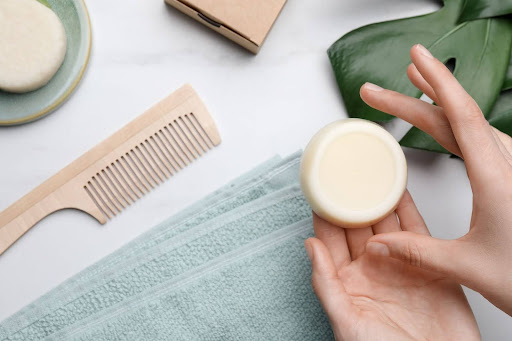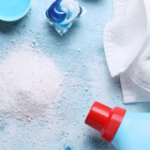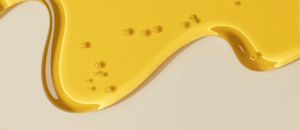There is a major trend in both the cosmetic and detergent industries to move towards concentrated formats. This shift is important from a sustainability perspective, as it reduces packaging size, cuts down on single-use plastics, lowers transportation costs, and minimises chemical overuse through unit dosing.
However, formulating these products poses challenges, as it requires low to no water in raw materials and technical expertise to achieve the desired performance, stability, and aesthetic. In most cases, simply reducing or removing water content isn’t feasible.
This blog focuses on cosmetic products; we’ll cover detergents in a separate post.
Types of Waterless Formats
- Solid bars
- Dilutable powders
- Water-soluble pouches
- Emulsifiable oils and gels
- Tablets
Solid Bars
Application Types: Syndet bars (e.g., Dove-type bars), shampoo bars, combination shampoo/body wash bars, deodorant/antiperspirant sticks, hair conditioner bars, and soap bars.
Solid bars can generally be made through two methods: hot melt or extrusion (sometimes referred to as “milled”). Extrusion is often used for soap bars, where soap noodles are “milled” with fragrance and colour, extruded, cut to size, and moulded.
Our Input in Extruded Soap Bars:
- Quality fragrances from Carrubba
- Colour options applicable to all areas of cosmetics
- A large range of cosmetic preservatives
- Additives to prevent cracking, such as Cosmosurf CE140 from Surfatech
- Deodorants like Flexicare ZR-L from the Flexicare range
- High-grade calcium carbonate for an aesthetically pleasing pearl-white effect and reduced shine
- Emollients, such as Dermalcare LIA from Syensqo
- Active ingredients like Pea.Protein and Hair App from Sinerga
Hot Melt Bars
Hot melt bars can be used for various applications, from simple hand soap to shampoo bars, conditioning bars, or deodorant/antiperspirant sticks. These bars can also serve multifunctional purposes, such as a combined emollient body wash and shampoo block.
The foundation for these bars typically involves a glycol stearate-type emulsifier and structuring agent, such as Phytocream 2000 from Sinerga or Linkwax AM200, providing solidity.
Additions to this base may include:
- Natural waxes like Mandorwax (sweet almond wax) from Sinerga, which adds shine and enhances lubricity
- Natural oils, butters, and emollient esters to improve texture and feel, with a range of oils and butters from multiple suppliers
In foaming products, powdered surfactants like Rhodapon LZS 94 RPB (Sodium Cocoyl Sulfate) or its needle form, Rhodapon CAS 100N MB from Syensqo. For sulfate-free options, Geropon TC 95 (Sodium Cocoyl Methyl Taurate) and Geropon T77 (Sodium Oleyl Methyl Taurate) are available, as well as Alpha Olefin Sulfonate (Rhodacal LSS 92 RP), all of which are high-foaming agents.
To stabilise and boost foam, powdered Cocoamidopropyl Betaines like Mackam 2800 and Mackam 1200 can be added. Emollient vegetable oils and butters, as well as whitening agents like Omyacare S70KP (a specific grade of calcium carbonate from Omya), are also available to enhance product performance and appearance.
A dispersing agent such as Cosmosurf CE140 from Surfatech can be added to distribute powdered additives evenly in the molten product, prevent cracking, and create a silky film on the skin. Additionally, active ingredients such as fermented oils from LABIO and a full range of natural and synthetic fragrances and colours can provide unique benefits and visual appeal.
Dilutable Powders and Liquids
Concentrates with minimal to no water content can be diluted to form stock solutions for hand soaps, mousses, shampoos, body washes, conditioners, and skin creams. These products are often packaged in soluble packaging, though smaller plastic, paper, or glass containers can also be used. Concentrated products require highly concentrated raw materials, given their low water content.
Soluble Packaging
We have in-house production of water-soluble sachets, including the PVA water-soluble film itself. We also formulate free-flowing powders that thicken upon dilution and disperse with a simple shake. This technology extends to water-free or low-water liquid systems.
See our Q&A blog on water soluble sachets for more details.
Raw Materials We Supply in This Area:
- Powdered surfactants, such as high-foaming Sodium Cocoyl Sulfate, Sodium Methyl Cocoyl Taurate, Sodium Methyl Oleyl Taurate, and Sodium Alpha Olefin Sulfonate (Rhodapon LZS 94 RPB, Geropon TC 95, Geropon T77, and Rhodacal LSS 92 RP). All are fine, free-flowing powders for high-foaming shampoos, body washes, hand washes, and hand wash mousses.
- High-active liquid surfactants like Mackamine C5 (Coconut Diethanolamide).
- Conditioning agents, mainly for powders, including cationic guar derivatives (e.g., Jaguar/Naternal grades like Naternal C14S). These powdered cationic guars provide viscosity to diluted products, excellent conditioning, and are anionic compatible for conditioning shampoos.
- Thickeners in powder form, including Tylose HEC grades (Hydroxyethyl Cellulose), Aquasol CMC grades (Sodium Carboxymethyl Cellulose), and Jaguar HP grades (Hydroxypropyl Guar). These powder grades disperse easily in cold water, increasing viscosity and compatibility with both anionic and cationic systems.
We have developed the technology to formulate these types of products, overcoming common challenges.
Fragrance can be a challenge due to its primarily liquid form, but expert formulation can resolve this through absorption on various substrates.
When it comes to preservatives in concentrates, the main challenge is ensuring the correct level upon dilution. For instance, a 10% dilution would require preservative levels in the concentrate to be 10 times the amount needed in the final product. High preservative levels can cause caking in powders, but single-use powders or tablets do not require preservatives. We offer limited powdered cosmetic preservatives and have developed systems to address this issue, depending on product type.
Dilutable Liquid Concentrates
Achieving viscosity upon dilution requires specific surfactants in precise ratios. We have developed systems for hand washes, shampoos, and body washes. In anhydrous systems, like skin creams, certain polymers are used, which thicken upon dilution to create creams with a simple shake.
Oil Gels
A specific area of focus, oil gels typically do not use water, as traditional gelling polymers require it. Our products, such as those from Surfatech, achieve gelling by simple heating.
Tablets and Powder Blocks
We are all familiar with the ‘bath bomb,’ which is essentially a powder tablet used primarily to create fizz, foam, and fragrance. However, this concept could be expanded to incorporate more active effects. We also have a fantastic range of dyes and fragrances.
Toothpaste tablets are a niche product type, useful for travel as they are chewed in the mouth and then brushed. These tablets need to possess all the qualities of traditional toothpaste, such as foam, flavour, and active effects like anti-plaque, remineralisation, stain removal, and teeth whitening, but in a stable tablet form. We have in-house tableting expertise and access to raw materials from several suppliers to achieve these objectives. Similarly, pressed powders are another option, though these are applied directly to the toothbrush. We supply binders (e.g., Shin-Etsu), flavours (Carrubba), anti-plaque and stain-bleaching agents (Eureco HC P11, Phthalamidocaprylic acid/Cyclodextrin complex), calcium carbonate from Omya, and foaming agents from Syensqo and Verdant.
Antiperspirant/Deodorant Blocks
Similar technology to hot melt blocks, but these formulations obviously require an active deodorant or antiperspirant additive. At HARKE UK, we offer both in powder form, along with the raw materials and technology needed to formulate the block. We supply powdered deodorant actives, such as Caremag grades from ICL, concentrated zinc ricinoleate blends (ICT’s Flexicare ZR grades), and emollient actives and film formers from several suppliers.
Next Steps
Across all these formats, we have the technology and experience to tailor formulations to customer needs, providing raw material guidance and solutions.
Contact the HARKE Chemlink team today for further information or to discuss your next formulation.







